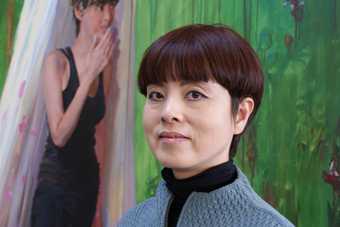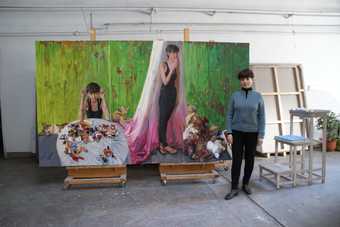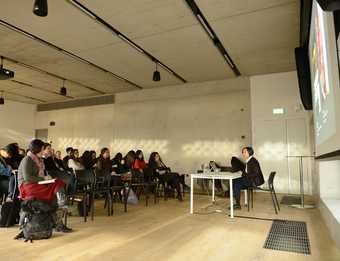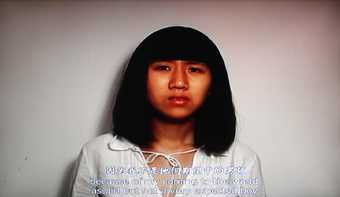
Yu Hong
Image courtesy of the artist
Monica Merlin: Let me begin by asking what it felt like when you were just starting out in your career?
Yu Hong: After graduating in 1988, I participated in an exhibition called The World of Women Artists in a venue known then as the ‘exhibition hall’ at the Central Academy of Fine Arts. The exhibition opened in 1990 and featured eight female artists. In the same year, I also held my first solo exhibition in the China Central Academy of Fine Arts gallery.
At that time, the number of women artists was already increasing. There were a few women artists in my teachers’ generation, but they were all quite exceptional. In fact, some women painters active in the 1950s and 1960s are scarcely studied nowadays, but they are truly excellent artists. Today, it is mostly the contemporary Chinese women artists who receive attention from scholars.
When I graduated, I was very young – in my early twenties – and I wanted to have an opportunity to express myself. So I made a lot of paintings and held a solo exhibition to display them, which received a lot of attention.
Monica Merlin: Do you think the Chinese contemporary art world has changed between then and now?
Yu Hong: There have been a lot of changes. In the late 1980s and early 1990s, there were hardly any galleries in Beijing, and even fewer elsewhere in China, so there really were not many places for students and young painters to exhibit their work. There was the Art Gallery, but for young artists it was very difficult to obtain an opportunity to show their work there. Besides, there were very few exhibitions in general. Nowadays there are exhibitions happening every day and every weekend, so many that you cannot possibly see all of them. But back then, if there was an exhibition on in Beijing, everyone would bicycle there to see it. So there was a thirst for art, but few opportunities for expression or exhibition.
Monica Merlin: What would you say is the biggest change in your own artistic practice from the time you started to today?
Yu Hong: I do not think there has been any change. I think the themes and the content of my paintings have changed, but the core of my work has remained the same. It has always been about people. I like painting people, their characters and their lives, through an exploration of various themes and perspectives.
Monica Merlin: Do you think the situation for women artists in China has changed since the early 1990s?
Yu Hong: Yes. In the early 1990s there were very few opportunities for women artists to exhibit their works. The exhibition I curated, The World of Women Artists, was quite influential at the time because it gave people a sudden awareness that there was a whole new wave of young women painters in their twenties who were full of passion and were producing a lot of work. However, that exhibition was essentially the only one that focused on women artists at the time. Nowadays, there are many such exhibitions and many more opportunities for female artists. Whenever there is a graduate show, lots of galleries will attend in the hope of finding new young artists. That did not happen back then.
Monica Merlin: Do you think that men and women artists are equal in today’s art world?
Yu Hong: I think that the situation for men and women in the art world mirrors the way things are for men and women in society. However, relatively speaking, I think art schools offer equal opportunities, since everything depends on your ability and the quality of your work. But this kind of meritocracy does not exist in society at large. I have been quite lucky in that I have not personally suffered any gender discrimination, but generally speaking women artists have fewer opportunities than male artists to show their work. Of course, things are much better than they were in the Yuan or the Ming dynasty, but still there are fewer opportunities for female artists.
Monica Merlin: In general, when I look at your paintings I get an optimistic feeling from them. Are you an optimistic person?
Yu Hong: I have an optimistic side and I like making paintings that deliver warm feelings. But pessimism is also present in my work. You probably got the sense of optimism and happiness because I use vivid colours but my work also harbours worries about the world and people.
Monica Merlin: That is true. I saw one series you made, in which the women you painted all seemed to be somewhat unnerving and lonely.
Yu Hong: Yes, both men and women experience loneliness, and both have to face the cruelty of this world. This is especially true in China where, because of its rapid development and lack of resources, it is very hard for people to improve their lives.
Monica Merlin: You are about to hold a new solo exhibition. What are your new works about?
Yu Hong: This exhibition, Wondering Clouds, opens at the end of the month [November 2013] at Long March Space gallery. It consists of two parts because there are two spaces at the gallery. The first part is a large-scale work, which I painted last year. It is made up of six canvases and is eighteen metres long. The painting is about real life and merges a variety of elements, such as explosions, lightning, thunderstorms, clouds and earth.
The other theme of the exhibition is depression. I started to work on a series towards the end of last year and finished it this year. I painted six people in total, all of whom suffered from depression. I think everyone has a depressive side. Because of China’s rapid development and thirst for material things, many people are living under a lot of stress and experiencing depression, including several of my friends. This is how I came to choose this topic. Of the six people, four are women and two are men. Most of them work in the arts and related fields, some are artists, some authors and some musicians.
Monica Merlin: So you always paint real people? What was the process behind the paintings for this series?
Yu Hong: Yes. I first interviewed them in order to understand more about their backgrounds and then I photographed them. Afterwards, I painted them in my studio from the photographs.
Monica Merlin: This series of paintings definitely has a very different feel to your previous ones, especially the ones with golden backgrounds.
Yu Hong: Yes, this painting, for instance, was painted very recently. The woman in the painting is a photographer, who also writes for magazines. She is a very clever and talented woman. When I interviewed her, she brought out a lot of stuffed bears that she has collected since she was young. She grew up in another city and only later moved to Beijing. Every time she moved, she took her bears with her. The bears are part of her memory of growing up. I thought this was very moving and so I painted her with her bears. I also included the cats and dogs that she keeps as pets.
Monica Merlin: Do you think that talking to the subjects of your paintings could help them deal with their depression? Do you think that their problems are related to larger societal pressures, or their personal experiences?
Yu Hong: First of all, I think that people who suffer from depression have a naturally sensitive disposition. They tend to more readily see the negative aspects of things, while others may see positive ones. So they tend to be sensitive to certain things, which then become amplified in a way that makes them feel stressed and anxious. Secondly, their depression cannot be separated from social influences. Our society’s lust for material things, coupled with an improvement in living conditions, have no doubt contributed to the huge amount of stress they feel.
Monica Merlin: You currently teach at the Art Academy. When you talk to your students, do you get the impression that the stress they experience as young people is related to a particular aspect of society?
Yu Hong: Most of the stress the students experience comes from their struggle to establish a place in society. After they graduate, they need to find a job, sort out their household registration permit, find a place to live and earn some money. Only after they have established this foundation can they start to think about making art. This is different from the past. Back then, the government or your work unit would be responsible for finding housing for you. Even though it might not have been particularly luxurious, it was at least a place to live. Now, young people are under a lot of stress to find a place by themselves, so they have to make money. Only after they earn more money can they rent a studio to make art. That is why people are under a lot of pressure now. I think it is the same here as it is in the UK.
Monica Merlin: What guidance do you give them if they say they want to become a great artist?
Yu Hong: I tell them first of all to ensure the basics of life, by which I mean rent a place to live in and settle down. Then they can paint in their spare time, on the weekends, because there are actually many ‘weekend painters’ in art history. It is definitely not the case that once you have another job you cannot be an artist. It just depends on how big your desire is to make art. If you really want to do something then you will definitely do it well. If you do not actually want to do something then you will quite easily find excuses to quit.
Monica Merlin: What themes do you want to explore in your paintings in the future? Will you continue to paint people?
Yu Hong: Yes, definitely. I have always been interested in people and I enjoy painting them. In the future I will explore different themes, because I tend to change themes every one to four years. I know that I have always wanted to paint myths, such as ancient Chinese and Greek myths, and to explore the relationship between myth and reality. I think it will be an interesting theme to work on.
Monica Merlin: Yes, I think these connections to European and Egyptian art history are evident in your work. And also some of your works place modern women in Song dynasty paintings.
Yu Hong: I am interested in ancient cultures in all parts of the world. I went to Egypt in the 1990s and loved it. I would not say that I understood Egyptian art – it has such depth and grandeur – but it was wonderful just to scratch the surface. I hope that I can make paintings that are connected to these ancient traditions.
Monica Merlin: I am really looking forward to your solo exhibition.
Yu Hong: So am I. I have not seen what these paintings look like when they are all together yet.
Monica Merlin: So you will use both spaces at the Long March Space gallery for your exhibition?
Yu Hong: Yes. As mentioned earlier, the larger space will be used for exhibiting the large painting on six canvases.

Yu Hong
On the Clouds 2012
Image courtesy of the artist
Monica Merlin: Could you describe it to me? It contains a lot of different parts!
Yu Hong: The work is called On the Clouds. I painted it in 2012. The inspiration came when I was on the plane and saw some beautiful golden clouds as the sun was setting. But when I looked further down, I saw that it was night on the land below and the city lights were already glinting. This image left a very strong impression on me. It was a long time ago, and I had been thinking about painting it since I saw it. Of course, it is not that interesting to paint just the clouds and the scenery, so I incorporated real people into the space.
There are several parts to the painting. For example, there are some new-born babies suggesting the beginning of a new life. There are two children performing acrobatics and some clouds that look like fire, both of which give a hint of danger. This reflects the way in which our lives are surrounded by all kinds of danger. It looks a bit like the apocalypse, but it could also be the beginning of a new world.
Another section shows a city at night, with snowy mountains, fire and lightning. It is not a real city – but that is not important. The people, however, are from real life. There are two people fighting and some workers are shown having a nap on top of a utility pole after a morning’s hard work; these scenes are all based on photographs. When you put these normal people up in the sky among the clouds, they undergo a transformation. They are no longer the people you see on the street in daily life – they become more interesting.
Another area of the painting, which is somewhat erotic, explores the weariness and difficulty one experiences in life. The figures depicted are all asleep – something I have painted many times in the past. Because of China’s rapid development, everybody is constantly quite tired from working, so most people are normally in need of a good sleep. The painting also shows a criminal suspect who has been caught and is about to be sent into prison.
I think that this world is very chaotic and complex, and though you might not know what is going on, all the people are mixed up together, just like they are in this painting. This is what the world looks like in my eyes.
Monica Merlin: Do you often work from photographs? Do you take them yourself?
Yu Hong: Yes, I use them most of the time. In the past, I would work from my own photographs, but sometimes I also use photographs from the Internet for practical reasons. There are dozens of people in this painting – it would not be possible to photograph each one of them.
Monica Merlin: I would like to go back to the theme of women artists, as there are very few books on them written in English. Women artists also do not feature prominently in books on Chinese contemporary art. What is the situation like for women artists in the contemporary art world?
Yu Hong: Although there are not many female artists in China, there are some very good ones. Some of them are very young, still in their twenties and thirties. But still, there are not enough female artists and they need more opportunities to exhibit.
Monica Merlin: I notice that exhibitions in Europe and elsewhere mostly feature Chinese male artists, which I think has a slightly unfair impact on how Chinese contemporary art is received outside of China. There are many talented women artists, but it seems that they are not given much space. I really hope that my research can benefit Chinese contemporary art by shedding light on a neglected corner of the contemporary art scene.
Yu Hong: China is quite different from Europe in that more and more women are beginning to study art and art history. In the past, it was mostly men. The number of female professors has always been small, but now there are roughly as many female art students as male ones. When I began my degree in 1984, I was the only woman in the oil painting department – the other twelve were all men. Compared to that period, there are now many more female art students and women artists. However, women still face a long and difficult road to become artists, because when many women get married and have children, they simply do not have enough time or energy left to continue their artistic work, so a lot of them gradually drop out.
That said, things are not too bad – there are a fair number of women artists. Actually, I think the more important issue is that there are very few art critics who are women in China –probably only two or three – even fewer than women artists.
Monica Merlin: Do you think that male critics approach art and the world from a different perspective than female critics?
Yu Hong: Of course. As China began the Economic Reform in the late 1970s and early 1980s, Western thought and philosophy were imported to China. But while psychoanalysis and existentialism was brought over from the West, feminism was not. Most people had never heard of feminism until 1995. So there was a period of over a decade between the vast importation of western ideas in the early 1980s and the introduction of feminism in the 1990s. I think it is strange that among the many new ideas during reform and opening up, feminism did not feature. It seems to have been purposefully filtered out. For example, translators might have decided not to translate feminism into Chinese, because they believed it was not important enough.
Monica Merlin: Actually, feminism was introduced to China in the early twentieth century, but there is not much historical documentation of it. There were actually many incredible women at that time who promoted feminism.
Yu Hong: Yes, but feminist ideas were not well disseminated because of the subsequent 1949 Communist Revolution and the Cultural Revolution. That is why many people had not heard of feminism.

Yu Hong
Image courtesy of the artist
Monica Merlin: What do you think about feminism today?
Yu Hong: People often ask me if I am a feminist. My reply is that branding something with ‘ism’ in Chinese is quite a serious thing, which is perhaps different from the effect the suffix has in English. These ‘ism’ words in Chinese, such as ‘feminism’ and ‘communism’, imply serious principles for which you would sacrifice your life. In this sense, I would not call myself a ‘feminist’, because I would not fight for feminism with my life. For me, feminism is more like a perspective to look at the world. It is a part of my life, but not my entire life.
Monica Merlin: I agree that in Chinese calling something ‘ism’ introduces too much pressure. But I think that the fundamental beliefs of feminism are very important to Chinese women.
Yu Hong: Absolutely. In China we had a feudal society for 2,000 years in which women occupied a secondary status to men. But now it is getting better. To a certain extent, the one-child policy has had a beneficial effect on women in China. In the past, a family would have likely had many children, as many as ten, and it is likely that they would not have paid for the girls to go to school. With the one-child policy, a family can only have one child, so girls now have close to equal access to education as boys. It is strange the way things turn out.
Monica Merlin: Are you planning overseas exhibitions?
Yu Hong: Yes. One of my works, Questions for Heaven, will be in a group show in December [2013] at the China Institute in New York. I probably will not be able to go in person though, since I have to teach here in Beijing.
Monica Merlin interviewed Yu Hong in her studio in Beijing on 7 November 2013.
Published 20 March 2018



